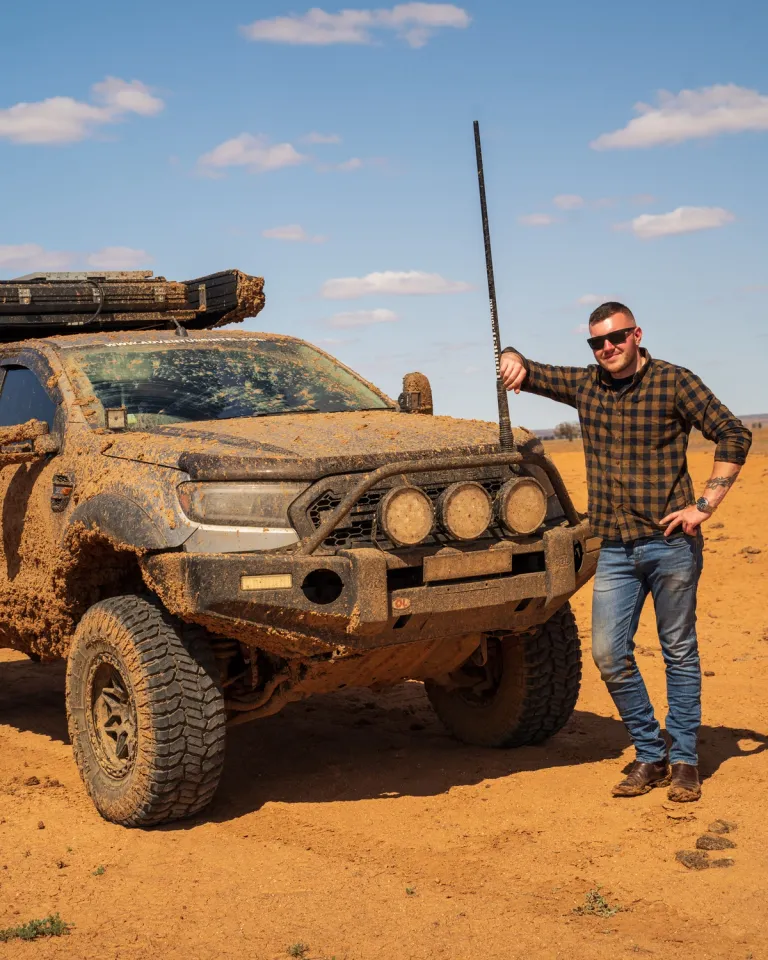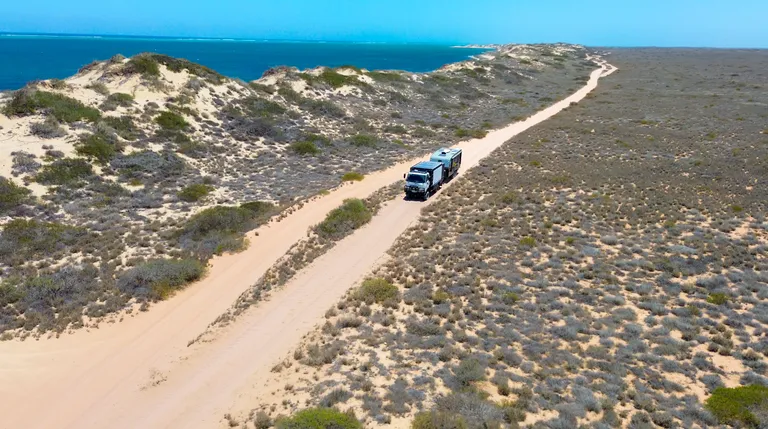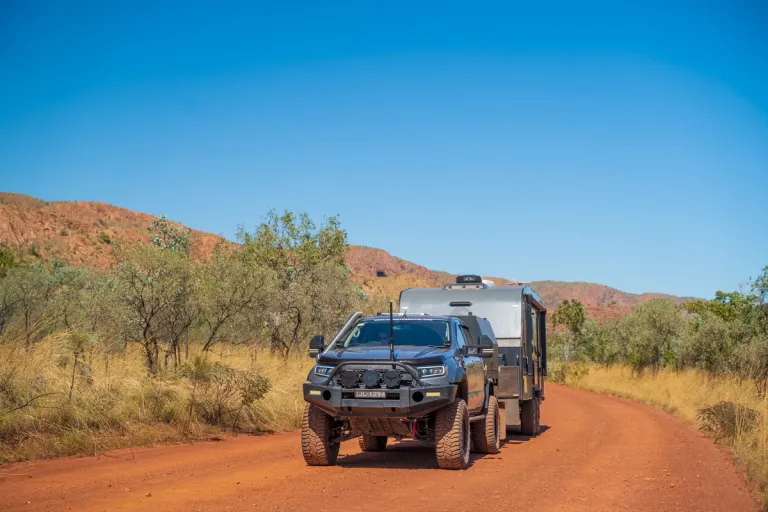The Ford F-150 isn’t just a ute, it’s an icon. In the US, they sell one every 40 seconds. For years, we’ve watched them tear across deserts and tow heavy loads on YouTube and thought, “Yeah, but how would it handle a real Aussie flogging?” You know, bulldust, ruts, and corrugations that are so brutal they’ll loosen your dental work.
Well, now we get to find out. The F-150 has officially landed on Aussie soil, fully converted to right-hand drive and ready for duty. It’s got the size, grunt, and towing history to make even seasoned tourers take notice, and it’s already turning heads from the servo to the Simmo.
Let’s cut through the hype. Is the F-150 actually built for our backyard, or is it just a chrome-plated “Yank Tank” destined for Bunnings runs and flexing at the local boat ramp? At Club 4X4, we get asked this kind of thing all the time, so, we lined one up, aired down the tyres, and took it to the bush for an epic Ford F-150 Review.
Overview of the Ford F-150
The Ford F-150 has been America’s best-selling vehicle for more than four decades, but it’s a new player on Aussie soil. To be compliant in Australia the F-150 is given a right-hand-drive conversion by RMA Automotive Australia and comes in two trim levels for our market: the work-ready XLT and the more luxury Lariat.
Under the bonnet, you’ll find the same 3.5L EcoBoost V6 in both variants, a turbo petrol donk with 298kW and a fairly hefty 678Nm of torque. For the non-numbers people, that’s enough grunt to easily get a caravan or boat shifting without breaking a sweat.
Inside, the cabin is large enough to make you feel like you need to book a flight to the passenger side. Both the XLT and Lariat seat five, with enough legroom in the back for actual grown-ups, not just the kids. Up front, you get a large touchscreen, Apple CarPlay and Android Auto, and a fully digital dash on the Lariat. There’s clever storage everywhere you look, including a fold out work desk and out back, the tub can swallow a family’s worth of camping gear, bikes, or half a hardware store. On paper, it seems like it was built for Aussie tourers, families, and anyone who needs to move serious kit across long distances. But what about in real life? Cue the Ford F-150 review, Australia style.
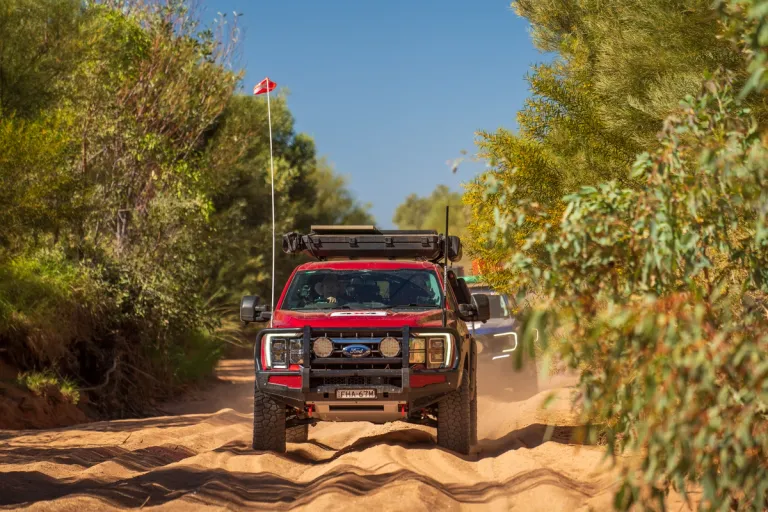
Ford 4x4 driving through sandy forest in convoy
Detailed Variant Reviews:
Ford F-150 XLT Review:
Let’s start with the Ford F-150 XLT review. The F-150 XLT is the so-called base model in the Aussie lineup, though there’s nothing “base” about its size… or stance. It’s big, brash, and unmistakably American, but not so outrageous you’ll feel like you’ve driven a tank to the school drop off. Inside, you get a tough yet functional cabin with cloth seats and durable surfaces. It doesn’t scream luxury, but it’s not supposed to. It’s the work hard01, play hard variant and it shows.
Under the bonnet, you’ll find Ford’s well-proven 3.5L EcoBoost V6, which, as mentioned, delivers a hefty 298kW and 678Nm. That’s more grunt than most V8s on sale in Australia, and it shows the moment you start towing or throw a full load in the back. What’s especially impressive is how it delivers that V8-level performance with V6 fuel economy, a big win for tourers chasing range without sacrificing pulling power.
On the bitumen, it’s surprisingly refined, quiet, smooth, and composed for a vehicle of this scale and trim level. That said, we should point out that while we found it easy to drive, the steering can feel a bit vague, especially when compared to more nimble (and smaller) utes like the Ranger or HiLux. It’s not a deal breaker, but we’d love a bit more weight and feedback to match the F-150’s footprint.
Off-road, the Ford F-150 XLT is more capable than you might expect for something of its size. It’s got low-range gearing, decent clearance, and doesn’t mind getting dirty. We gave it a solid run towing through a soggy clay pan after rain and it didn’t flinch, but it’s not invincible. The sheer size of the vehicle means you’ll feel the pinch on tight or narrow bush tracks and likely find yourself doing a three-point turn where you used to just drive straight around.
So what’s the verdict? This Ford F-150 XLT review shows it’s a serious long-distance tourer with the muscle to tow and the manners to cruise. For Aussie adventurers who want space, power, and peace of mind, it earns its place in the conversation, easily.
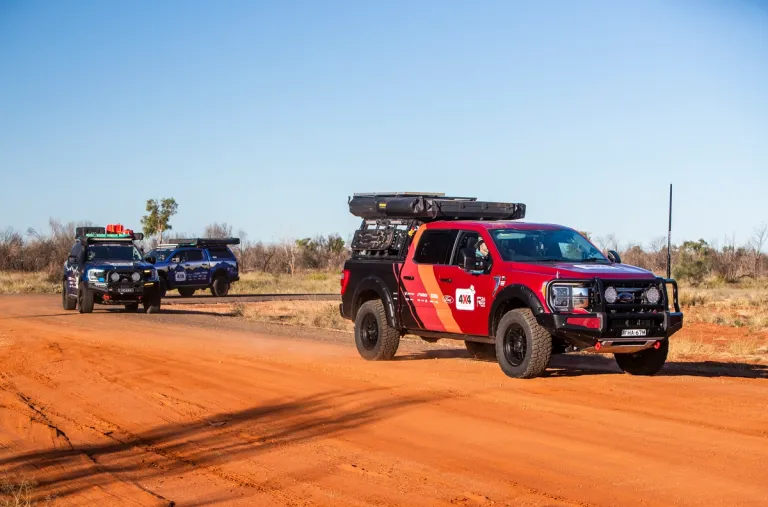
convoy of 4x4s driving though the desert
Ford F-150 Lariat Review:
Now for the Ford F-150 Lariat review. This is where brawn meets a good dose of what we at Club 4X4 like to call “bush-ready business class.” You’re still getting that 3.5L EcoBoost V6 (thankfully), with all the grunt and towing torque it brings, but now it’s dressed to impress. Leather trim, chrome accents, and enough tech to make a Range Rover feel a bit undercooked. The driving experience is seriously refined, with the luxury interior making you feel like you’re cruising in a lounge chair, not a full-size American truck.
Inside, the jump up from the XLT trim is immediately noticeable. Heated and cooled front seats, a giant 12-inch touchscreen, digital dash, and premium finishes throughout. The cabin is quieter, better insulated, and clearly aimed at those who spend serious time behind the wheel. You’ll also find extra USB ports and a solid suite of driver-assist features that make long hauls more relaxed.
While undertaking this Ford F-150 Lariat review we learnt that both on the road and on the rough stuff, the Lariat eats up distance with confidence. We found the longer wheelbase gives it a more planted, comfortable ride, especially when compared to the Ford Ranger and Everest on the same surfaces. It still tows up to 4.5 tonnes (braked) and handles rougher tracks without breaking a sweat. Because it shares its mechanical bones with the XLT, you’re not giving up any off-road ability, it’s just wrapped in a far more polished package. Remember though, this is a full-size rig, so tight tracks will see you testing your line picking ability.
Performance and Towing Capabilities:
Let’s be real, if you’re feeling the need for an F-150, you’re probably not just popping down to the shops for milk. This thing’s built to haul, and it does so with confidence. Both the XLT and Lariat are rated to tow up to 4.5 tonnes (braked) straight from the dealership.
The 3.5L EcoBoost V6 under the bonnet has grunt everywhere you need it, especially down low in the rev-range, which makes towing feel effortless. Whether you're crawling out of a campsite or overtaking triple road trains on the Nullarbor, it gets the job done without any drama and still manages to feel pokey when you press the loud pedal. The 10-speed auto is smooth and it always seems to be in the right gear, despite there being so many of them. We get the feeling Ford spent some serious time tuning the gearbox on these things.
Hitched up, out on the road, the long wheelbase and track keep things rock solid, even with a couple of tonnes swinging off the back. Drivers also benefit from a trailer brake controller, sway control, and tow/haul mode, which all come baked in. It’s a genuine thoroughbred tow rig, not a show pony.
Now, about fuel economy. Look, it’s a full-size petrol truck, not a Prius. When towing, you’ll see numbers in the mid to high teens (15-19L/100km), depending on your load and how heavy your right foot is. Unloaded, it calms down a bit to a somewhat astonishing 10-14 litres per 100 kilometres.
Behind the wheel you do get the feeling the F-150 is happy to tow all day, everyday no matter what weather or terrain you’re towing in. We were particularly blown away with its ability to pull a decent load through deep, thick mud without struggling or bogging down.
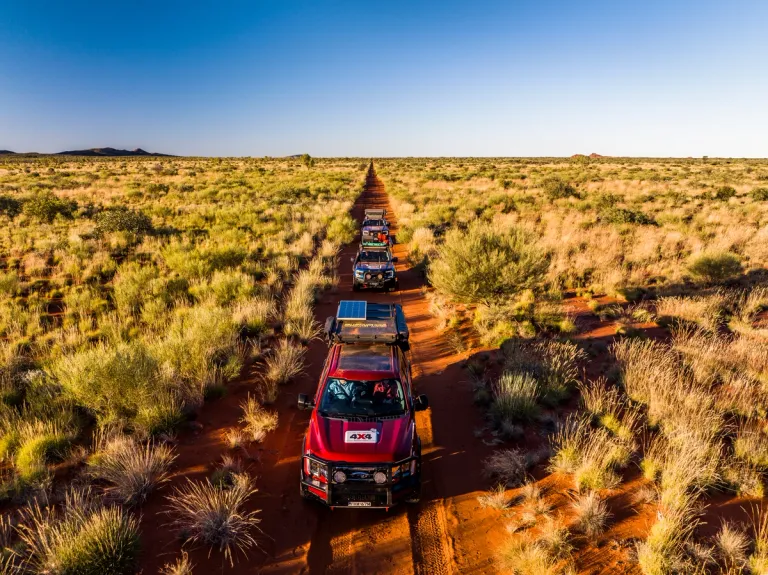
convoy of ford 4x4s driving through a desert with small grasses
Practical FAQs about the Ford F-150:
Now that the Ford F-150 is officially on Aussie soil and not just available through private imports, the questions have been rolling in thick and fast. Whether it’s in the inbox or around the campfire, here’s what people keep asking:
How much is a Ford F-150 in Australia?
If you’re sitting there wondering “how much does a Ford F-150 cost?” That’s fair. At the time of writing, the F-150 XLT kicks off around $106,950 before on-roads. The Lariat climbs closer to $139,950 which is a whole lot of truck compared to a LandCruiser.
How long is a Ford F-150 extended cab?
We’ve been getting this one a lot. Unfortunately for those wondering, the F-150 isn’t offered in an extended cab here in Australia. Both models come as a dual cab, offered in two wheelbase options: short wheelbase (SWB) and long wheelbase (LWB). The SWB version comes in at 5884mm long, 2030mm wide (2430mm with mirrors), and 1995mm high. Go for the LWB, and length stretches out to 6184mm while width and height stay the same. The wheelbase itself measures 3683mm on the SWB and 3994mm on the LWB. No matter which wheelbase, it’s not small, so measure your driveway. Twice.
How much weight can a Ford F-150 carry?
The Aussie-spec Ford F-150 has a payload capacity of up to 794kg for the XLT SWB and 685kg for the Lariat LWB. It’s not exactly a heavy hauler payload like a single-cab ute with a steel tray would be, but it’ll easily handle a full load of camping gear, tools, swags, and whatever else you can throw in for a weekend off-grid. Just keep an eye on what you’re packing, especially if you’re also towing.
How much does a Ford F150 tow?
4,500kg braked. That’s just about anything short of a bulldozer. And even then, it’d probably give it a crack.
What does STX mean on a Ford F-150?
The STX is a US-only trim. You won’t find it on Aussie-spec models, so no, you haven’t missed a secret option pack.
What is the fuel economy of a Ford F-150?
As above, high teens when towing, high single digits to low tens in regular driving. Not bad for a full-size petrol-powered truck we reckon.
Final Thoughts: Is the Ford F-150 Worth It?
It’s big, bold, and built to tow just about anything. The Ford F-150 has finally touched down in Australia with proper factory backing, and in our opinion, it’s been well worth the wait. Now, let’s just call a spade a spade: the Ford F-150 isn’t for everyone, and that’s exactly the point. If all you’re doing is ducking to the hardware store or doing the school run, you’ll be cursing its size by day three. However, if you’ve got big towing needs, serious gear, and a habit of chasing the lines, this thing makes a lot of sense.
It tows hard, drives well, and eats up long-distance trips without you or it breaking a sweat. Yeah, it’s pricey. Yes, it’s massive. But if you’re the kind of person who needs what it offers and knows how to use it, you’ll struggle to find better.
Protect your adventures
For comprehensive insurance anywhere you can legally go in Australia

